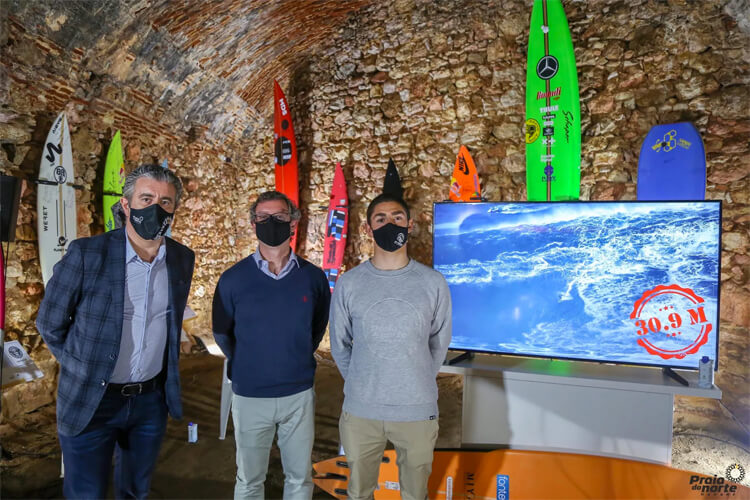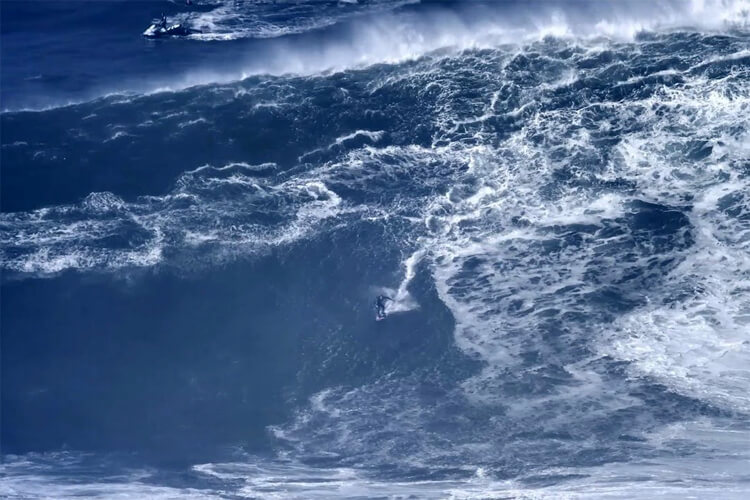António Laureano claims to have ridden the biggest wave ever at Praia do Norte in Nazaré, Portugal. The first measurement indicates a 101.4-foot (30.9 meters) wave.
On October 29, 2020, the Portuguese surfer woke up early in the morning and couldn't believe his eyes. The conditions at Nazaré's famous peak were outstanding.
"I've never seen waves breaking so far from the coast," António told his father, Ramon Laureano.
"To be honest, neither have I," replied his dad.
António is 18 years old.
He's finishing high school but before embracing university life, the young surfer wants to take a few years off to follow his surfing dreams.
António, also known as Tony, started surfing at the age of four, and by the time he was ten, he was already hooked.
"Riding the biggest wave of all time is a career goal," underlines Laureano.
So, on October 29, 2020, father and son saw an opportunity, and on the last wave of the session, Ramon asked António if he wanted to go on that one.
"As soon as I started to go down the wave, I gained a lot of speed, as I had never gained. It was the greatest luck ever," revealed the young gun.
The footage speaks for itself.
Tony took off on a huge Nazaré wave, got over a few bumps created by jet skis that had just passed by, and began experiencing a mixture of feelings.
"Adrenaline, happiness, fear - all together. In the end, when I kicked out, I looked back and saw a giant wave behind me. I heard people screaming and applauding," he recalls.
When the team left the lineup and checked the images and videos, they realized they could have very well improved Rodrigo Koxa's record-breaking ride.
On November 8, 2017, the Brazilian surfed an 80-foot (24.38 meters) wave at Nazaré.
But this time, António and Ramon Laureano were not going to wait for the World Surf League (WSL) analysis.
Instead, they decided to ask for an independent and scientific measurement.
Measuring Big Waves
University of Lisbon's Faculty of Human Kinetics (FMHUL) has been studying surfing's multiple dimensions for a couple of decades.
In 2011, researchers from FMHUL measured Garrett McNamara's world record wave.
The academic team uses software that was not initially designed for measuring ocean waves but was fine-tuned to be scientifically relevant.
"One of the problems we face is that a wave is dynamic, so it will always be difficult to find stable zones to make measurements," Miguel Moreira, professor at FMHUL, told the media in a press conference.
"To get around this obstacle, we use the height of the surfer as a scale reference and then look for the crest of the wave - the highest point - and the trough."
To find a realistic value, scientists contacted the surfer and asked if he agreed on where the trough was set and defined.
In the end, Moreira and his team reached a final figure: 101.4 feet (30.9 meters).
But the FMHUL professor also leaves a message to those who think they can declare "official" world records.
"In order to announce world records, all waves should be measured using the same method," notes the academic.
"Even though there's always a margin for error, at least these margins of error would be the same for all analyses made."
"This is undoubtedly the biggest wave we have analyzed so far. And because we use the same method with most of the waves ridden in Nazaré that resulted in world records, this one is another world record," concluded Miguel Moreira.

Always a Subjective Call
The truth is that, when it comes to big wave surfing, there is no such thing as an "official" world record.
The height of a wave is not a 100-meter sprint race.
In the 100 meters, you can determine the exact finishing time and set new world records. In a moving wave, it's virtually impossible to determine its exact height.
The height of a wave is also not port wine.
There is only one place where you can produce official port wine - in Portugal's Douro Valley, near Porto.
Why? Because the famous fortified wine is exclusive to Portugal, and its name derives from the city of Porto.
Objectivity versus subjectivity. The crest, trough, and steepness of a traveling wave is not something you can "officially" determine.
Nevertheless, WSL partnered with the Guinness World Records (GWR) to award world record certificates, even though that doesn't necessarily mean they're "official" world records.
WSL and GWR are both private organizations with their own big wave surfing criteria for non-objective achievements.
Their criteria are as valid as any other as long as the quality of the variables and their interpretation follow valid and accurate scientific methods.
In the end, it's all about the credibility of the analysis - the better the formula, the better the results.
Judging by the FHKUL's approach, António Laureano is the first person ever to surf a 100-foot wave, beating Koxa's stunt by a comfortable margin.
Nevertheless, the young Portuguese surfer wants a broader consensus, so he'll patiently wait for WSL's call on his monumental achievement.
"As a kid, I grew up watching Garrett McNamara surfing those monsters," concludes António Laureano.
"Now, at 18, I feel like I'm close to breaking my idol's record, and this tells me I'm on the right path. It was the biggest wave of my life."
"As soon as I started to ride that wave, I realized it was massive. But it was only when I kicked out that I understood what I had accomplished."
The 100-foot wave has been ridden. What's next for big wave surfing?
